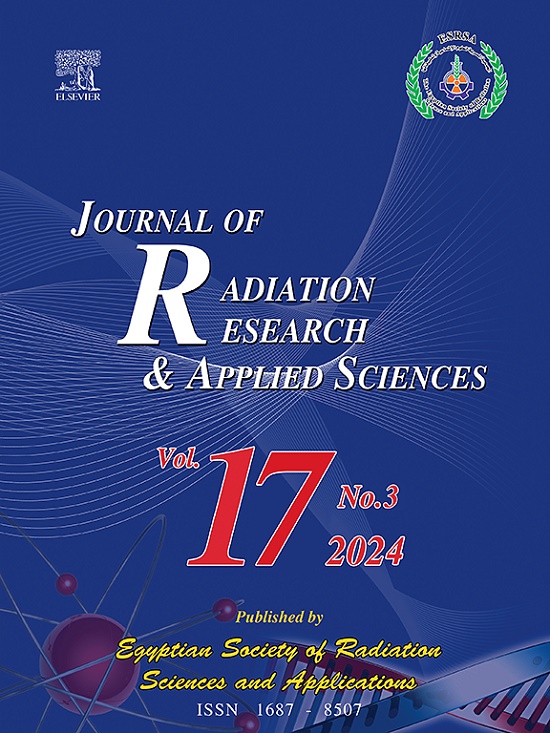基于剂量传递的磁流变仪电离室阵列校准新方法
IF 1.7
4区 综合性期刊
Q2 MULTIDISCIPLINARY SCIENCES
Journal of Radiation Research and Applied Sciences
Pub Date : 2025-03-31
DOI:10.1016/j.jrras.2025.101462
引用次数: 0
摘要
本研究旨在开发新的基于剂量转移的校准方法(中心场[CF]和菊花链[DC]),以克服传统的宽场(WF)校准方法在MR-linac环境下对IC PROFILER™电离室阵列进行校准的局限性,特别是解决剂量分布异常并增强与水箱参考数据的测量一致性。方法以水罐测量为参照,评价中心场(CF)和菊花链(DC)定标方法,并与太阳核公司(SNC)的宽场(WF)定标方法进行比较。剖面测量深度分别为0.9、2.9和4.9 cm,场地尺寸范围为10 × 10 cm2至40 × 22 cm2。准确度评估使用平坦无滤波器(FFF)光束表征和伽马通过率(GPR)与1% /1毫米标准。统计分析包括Kruskal-Wallis和Mann-Whitney U测试。结果与SNC方法相比,CF和DC方法与水箱剖面具有更好的一致性。在较大的区域(40 × 22 cm2和30 × 22 cm2), CF方法的平均GPR大于95.9%,中位数大于99.0%,优于SNC方法(平均GPR和中位数:89.2%;所有p值<;0.05和d值>;0.9)。直流方法也表现良好,在40 × 22 cm2的区域内实现了更高的GPRs,并且在较小的区域内实现了一致的精度。此外,当使用CF和DC方法时,光束表征指标(包括峰位置、对称性、半影、不平坦度和坡度)与水箱测量值的偏差较小,反映在更集中的差异分布中。结论由于磁场引起的探测器响应变化,SNC方法不足以检测MR-linac,导致剂量谱存在显著差异。相比之下,CF和DC方法显示出更高的准确性,提高了QA工作流程的可靠性。这些方法最大限度地降低了光束误校准的风险,确保了基于核磁共振直线放射治疗的安全性和有效性。本文章由计算机程序翻译,如有差异,请以英文原文为准。
Novel dose-transfer based array calibration methods for an ionization chamber array on MR-linac
Purpose
This study aims to develop novel dose-transfer-based calibration methods (central field [CF] and daisy chain [DC]) to overcome the limitations of conventional wide-field (WF) calibration for IC PROFILER™ ionization chamber arrays in MR-linac environments, specifically resolving dose profile anomalies and enhancing measurement consistency with water tank reference data.
Methods
The central field (CF) and daisy chain (DC) calibration methods were evaluated with water tank measurements as a reference and compared to the wide-field (WF) method from Sun Nuclear Corporation (SNC). Profiles were measured at depths of 0.9, 2.9, and 4.9 cm for field sizes ranging from 10 × 10 cm2 to 40 × 22 cm2. Accuracy was evaluated using flattening filter-free (FFF) beam characterization and gamma passing rate (GPR) with a 1 %/1 mm criterion. Statistical analyses included the Kruskal-Wallis and Mann-Whitney U tests. Effect size of GPR calculated using Cohen's d.
Results
The CF and DC methods showed superior agreement with water tank profiles compared to the SNC method. In larger fields (40 × 22 cm2 and 30 × 22 cm2), the CF method achieved mean GPRs above 95.9 % and median values over 99.0 %, outperforming the SNC method (mean and median GPR: 89.2 %; all p-values <0.05 and d-values >0.9). The DC method also performed well, achieving higher GPRs in the 40 × 22 cm2 field and consistent accuracy across smaller fields. Additionally, beam characterization metrics—including peak position, symmetry, penumbra, unflatness, and slope—exhibited smaller deviations from water tank measurements when using CF and DC methods, as reflected in more concentrated difference distributions.
Conclusion
The SNC method is insufficient for MR-linac due to magnetic field-induced variations in detector response, leading to significant discrepancies in dose profiles. In contrast, the CF and DC methods demonstrate superior accuracy, improving the reliability of QA workflows. By minimizing the risk of beam miscalibration, these methods ensure the safety and effectiveness of MR-linac-based radiotherapy.
求助全文
通过发布文献求助,成功后即可免费获取论文全文。
去求助
来源期刊

Journal of Radiation Research and Applied Sciences
MULTIDISCIPLINARY SCIENCES-
自引率
5.90%
发文量
130
审稿时长
16 weeks
期刊介绍:
Journal of Radiation Research and Applied Sciences provides a high quality medium for the publication of substantial, original and scientific and technological papers on the development and applications of nuclear, radiation and isotopes in biology, medicine, drugs, biochemistry, microbiology, agriculture, entomology, food technology, chemistry, physics, solid states, engineering, environmental and applied sciences.
 求助内容:
求助内容: 应助结果提醒方式:
应助结果提醒方式:


